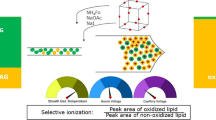Abstract
Lipid oxidation reactions in foods rich in healthy unsaturated fatty acids result in the formation of a wide range of oxidation products that can have adverse effects on food quality and safety. To improve the understanding of oxidation reactions and methods for their inhibition, detailed information on the type and levels of the oxidation products formed is required. Accurate measurement of lipid oxidation products, especially of the non-volatile aldehyde products, has so far been a challenge due to the low sensitivity and limited specificity of most analytical methods. Here, a novel normal-phase LC method that uses selective labeling of aldehydes and epoxides with 7-(diethylamino)coumarin-3-carbohydrazide (CHH) is described. Labeling of alkanals is quantitative within 10 h. For alkenals, conversion is only around 50% at 24 h reaction time. Detailed MS identification of all aldehydes and epoxides is possible by using high-resolution MS and data-dependent MS2 acquisition. Fluorescence detection was successfully used to quantify groups of oxidation products. Sensitivity was high enough to allow accurate quantification even in fresh mayonnaises, where levels of around only 0.3 g total aldehydes/kg oil were found. Individual species can be quantified by MS if suitable reference standards are available. If no standards can be used, semi-quantification using an average response factor is an option. Clearly, the novel derivatization method is suitable for monitoring secondary lipid oxidation products in the early stages of shelf life. This makes it an important tool for developing improved food products.

Selective labeling of low and high molecular weight lipid oxidation products with 7-(diethylamino) coumarin-3-carbohydrazide for identification and semi-quantification






Similar content being viewed by others
References
Andrés SC, Zaritzky NE, Califano a N. Innovations in the development of healthier chicken sausages formulated with different lipid sources. Poult Sci. 2009;88:1755–64. https://doi.org/10.3382/ps.2008-00495.
Yin H, Xu L, N a P. Free radical lipid peroxidation: mechanisms and analysis. Chem Rev. 2011;111(10):5944–72. https://doi.org/10.1021/cr200084z.
Vieira SA, Zhang G, Decker EA. Biological implications of lipid oxidation products. J Am Oil Chem Soc. 2017;94:339–51. https://doi.org/10.1007/s11746-017-2958-2.
Kanner J. Dietary advanced lipid oxidation endproducts are risk factors to human health. Mol Nutr Food Res. 2007;51:1094–101. https://doi.org/10.1002/mnfr.200600303.
Kubow S. Routes of formation and TOXIC consequences. Free Radic Biol Med. 1992;12:63–81.
Csala M, Kardon T, Legeza B, Lizák B, Mandl J, Margittai É, et al. On the role of 4-hydroxynonenal in health and disease. Biochim Biophys Acta - Mol Basis Dis. 2015;1852:826–38. https://doi.org/10.1016/j.bbadis.2015.01.015.
Guillén MD, Goicoechea E. Toxic oxygenated α,β-unsaturated aldehydes and their study in foods: a review. Crit Rev Food Sci Nutr. 2008;48:119–36. https://doi.org/10.1080/10408390601177613.
Barriuso B, Astiasarán I, Ansorena D. A review of analytical methods measuring lipid oxidation status in foods: a challenging task. Eur Food Res Technol. 2013;236:1–15. https://doi.org/10.1007/s00217-012-1866-9.
Spickett CM. The lipid peroxidation product 4-hydroxy-2-nonenal: advances in chemistry and analysis. Redox Biol. 2013;1:145–52. https://doi.org/10.1016/j.redox.2013.01.007.
Steenhorst-Slikkerveer L, Louter A, Janssen H-G, Bauer-Plank C. Analysis of nonvolatile lipid oxidation products in vegetable oils by normal-phase high-performance liquid chromatography with mass spectrometric detection. J Am Oil Chem Soc. 2000;77:837–45. https://doi.org/10.1007/s11746-000-0134-1.
Hollebrands B, Janssen H-G. Liquid chromatography—atmospheric pressure photo ionization-mass spectrometry analysis of the nonvolatile precursors of rancid smell in mayonnaise. LC-GC Eur. 2017;30(9):470–83.
Keeffe JR, Kresge a J, Schepp NP. Keto-enol equilibrium constants of simple Monofunctional aldehydes and ketones in aqueous solution. J Am Chem Soc. 1990;112:4862–8. https://doi.org/10.1021/ja00168a035.
Milic I, Hoffmann R, Fedorova M. Simultaneous detection of low and high molecular weight carbonylated compounds derived from lipid peroxidation by electrospray ionization-tandem mass spectrometry. Anal Chem. 2013;85:156–62. https://doi.org/10.1021/ac302356z.
Ni Z, Milic I, Fedorova M. Identification of carbonylated lipids from different phospholipid classes by shotgun and LC-MS lipidomics. Anal Bioanal Chem. 2015;407:5161–73. https://doi.org/10.1007/s00216-015-8536-2.
Merkx DWH, Hong GTS, Ermacora A, van Duynhoven JPM (2018) Rapid quantitative profiling of lipid oxidation products in a food emulsion by 1H NMR. Anal Chem. https://doi.org/10.1021/acs.analchem.8b00380
Dirksen A, Dawson PE. Rapid oxime and hydrazone ligations with aromatic aldehydes for biomolecular labeling. Bioconjug Chem. 2008;19:2543–8. https://doi.org/10.1021/bc800310p.
Guillén MD, Ruiz A. Monitoring the oxidation of unsaturated oils and formation of oxygenated aldehydes by proton NMR. Eur J Lipid Sci Technol. 2005;107:36–47. https://doi.org/10.1002/ejlt.200401056.
Acknowledgements
The authors thank Herrald Steenbergen for preparing the standards used in this research.
Author information
Authors and Affiliations
Corresponding author
Ethics declarations
Conflict of interest
At the time of writing, all authors were employed by Unilever, a major manufacturer of the food products studied in the manuscript.
Additional information
Published in the topical collection Food Safety Analysis with guest editor Steven J. Lehotay.
Electronic supplementary material
ESM 1
(PDF 1.14 MB)
Rights and permissions
About this article
Cite this article
Hollebrands, B., Varvaki, E., Kaal, S. et al. Selective labeling for the identification and semi-quantification of lipid aldehydes in food products. Anal Bioanal Chem 410, 5421–5429 (2018). https://doi.org/10.1007/s00216-018-1101-z
Received:
Revised:
Accepted:
Published:
Issue Date:
DOI: https://doi.org/10.1007/s00216-018-1101-z




